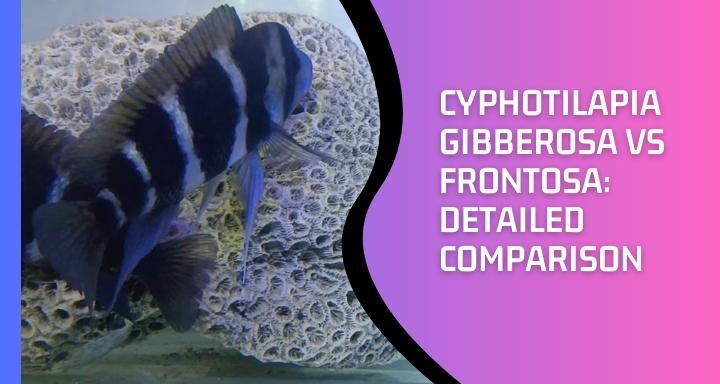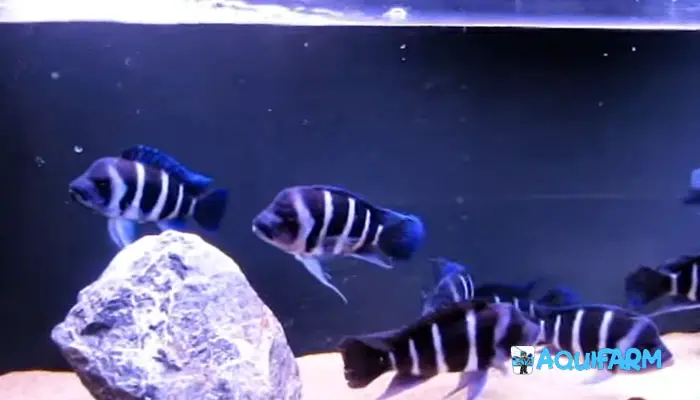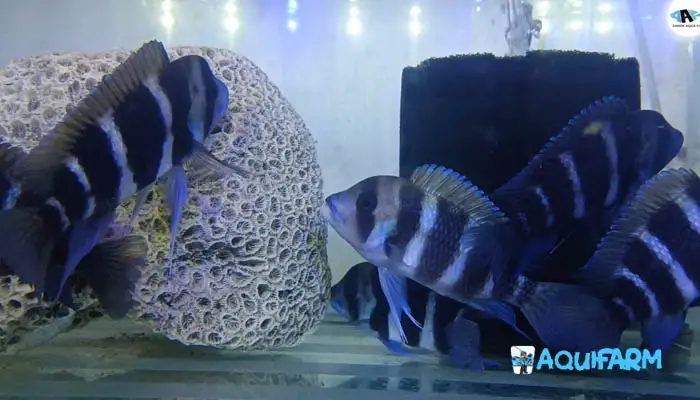
Both Cyphotilapia Gibberosa and Frontosa are from the same family that is cichlid. And both these fishes are charming for an aquarium. One might wonder, how are these guys different from one another?
Since they almost look alike, anyone can get confused while buying them for their aquariums. For an aspiring aquarist or even an experienced one, a million dollar question is- Cyphotilapia Gibberosa vs Frontosa, which one to choose?
Well, there are some features that help us to tell them apart. I’ve been keeping both these for years now so, in this article I’m going to share what I know about these two so that you can make an informed decision while purchasing one for your aquarium.
So, let’s get to know their differences in detail–
Cyphotilapia Gibberosa vs Frontosa : Which one is best?
[Short Comparison]
We can’t only rely on the looks of the fish, right? We need to think about their nature, food habits, the average size of an adult fish, the required environment, etc.
So, before choosing between cyphotilapia gibberosa and frontosa, let’s know their features first.
| Features | Cyphotilapia Gibberosa | Cyphotilapia Frontosa |
| Common Names |
|
|
| Origin | Tanganiya Lake, East Africa | Tanganiya Lake, East Africa |
| Family | Cichlid | Cichlid |
| Color and Looks |
|
|
| Nature |
|
|
| Food Habit |
|
|
| Required Environment of the aquariums or tank |
|
|
| Average size; Breeding way |
|
|
| Lifespan | 5 to 8 years | 15+ years |
| Average Size price | 40-50 dollars(approx.) | 30-40 dollars (approx.) |
Now let’s know these characteristics in detail to understand their differences more clearly.
Cyphotilapia Gibberosa vs Frontosa: In Details
First, we need to think about whether the fishes can be raised with other families or species or not. So, which cyphotilapia is perfect for our lake or aquarium? To choose the right one, we need to know the difference between both fishes.
We already know that both these fishes have the same genus and the same family (cichlids). The only thing that is different between these two fishes is their species. Due to their similarity the Cyphotilapia gibberosa is even known as blue zaire Frontosa sometimes. Even they are called cousin fish too.
No matter how similar they are, still they slightly differ in size, nature, price, and color. Sometimes the food habits of frontosa and gibberosa also don’t match.
Common Names
Cyphotilapia Gibberosa and Cyphotilapia Frontosa are their scientific names and they are very hard to remember. So, local sellers call it by their common names and may not know these scientific ones. For this reason, it’s better to acquaint ourselves with their common names.
Cyphotilapia Gibberosa
The common names of the cyphotilapia gibberosa are–
- Cichlid gibberosa
- Frrontosa blue zaire,
- Mpimbwe blue frontosa cichlid etc.
The gibberosa looks almost like the frontosa. However, it is more blue than a frontosa. That’s why the cyphotilapia is also known as blue zaire frontosa.
Cyphotilapia Frontosa
As the head of the cyphotilapia frontosa is humped, they are called humphead cichlids. It’s commonly known as–
- Humphead frontosa.
- Front cichlid,
- Frontosa cichlid.
Origin
Both cyphotilapia gibberosa and frontosa’s origin is East Africa,in a lake named Tanganiya.
But there is a twist that the cyphotilapia gibberosa was found 100 years after cyphotilapia frontosa in the same lake.
Color and Looks
For an aquarist, the color of the fish matters the most.Because colorful fishes increase the beauty of aquariums or lakes.
Cyphotilapia Gibberosa

Cyphotilapia gibberosa is dark blue in color. Sometimes you may find some purple cyphotilapia gibberosa as well.
So if you like these types of dark colors then you definitely should go for cyphotilapia gibberosa. Because of their dark bluish shade, they are commonly known as frontosa blue zaire.
Also the stripes number on the body of the cyphotilapia gibberosa are more than the cyphotilapia frontosa. Usually a Chyphitilapia gibberosa has 3 to 4 stripes on their body.
Cyphotilapia Frontosa

The colors of cyphotilapia frontosa are blue,gray or white. But,the blue shade of the cyphotilapia frontosa is less than the cyphotilapia gibberosa. The fins may also have a bluish tint.
Also, the stripes numbers on the body are less than the cyphotilapia gibberosa. But, the humphead does make this cyphotilapia frontosa more unique and interesting.
Nature
The nature of a fish is a very important matter to think about. Because, in the aquarium or in a lake or tank, we pet or raise various kinds of fish together.
So if the cyphotilapia is dangerous or predatory to other species,it will not be a happy incident for other fishes. So, let’s know their nature.
Cyphotilapia Gibberosa
Cyphotilapia gibberosa is generous to his own family. Like if you pet any other cichlid with cyphotilapia gibberosa, there will be no problem.But for a tiny size creature the cyphotilapia gibberosa can become a prey to ther aggressive fishes.
Cyphotilapia Frontosa
Like cyphotelapia gibberosa,Cyphitipaia frontosa also behave friendly with the cichlids and cyphotilapia.But Cyphitipaia’s are less predatory than the cyphotilapia gibberosa.With cyphotilapia, we can pet clown loaches,synodontis catfish, peacock cichlids etc.
Food Habits
Knowing food habits is important before buying a new kind of fish for the aquarium.
Cyphotilapia Gibberosa
Cyphotilapia Gibberosa is mainly carnivorous. They eat redworms or shrimps or mixed fish foods.But sometimes they behave like omnivores. That’s why they sometimes eat the plants in the aquariums.
Cyphotilapia Frontosa
Cyphotilapia Frontosa is mainly piscivorous and carnivorous.They love to eat shrimp or any other small-sized fish. Also, they eat prawns, krill, earthworms.
Required Environment of The Tank or Aquariums
A suitable environment in the aquarium is important for both cyphotilapia gibberosa and cyphotilapia frontosa.Without a suitable environment, they may die earlier.
So, always keep a pH meter with temperature Sensors. So that, if the temperature or pH downs or falls you get notified to take action.
Cyphotilapia Gibberosa
For the cyphotilapia gibberosa, the water type of the aquarium should be fresh water.As they are fishes of deep water, the tank or aquarium should hold 208-210 Litter (55 US Gallon) of water.
The temperature of the water should be 70-80 degrees Fahrenheit. And the Ph level should be neutral around 7.5-8.There must be rocks or small caves made of rocks to mimic their natural habitat. Because cyphotilapia gibberosa’s nature is staying near rock caves.
Cyphotilapia Frontosa
Cyphotilapia is also a deep, freshwater fish. So the minimum tank size for the cyphotilapia Frontosa should be 283-285 Liters( 75 US Gallon). The temperature should be 72-82 Degrees Fahrenheit.
And the PH level should be 7.8-8.2. They also need rocks on the tank or aquariums like the cyphotilapia frontosa.
Average Size and Breeding Way
If you want to buy the Cyphotilapia for breeding, then you must know about their average size.
Cyphotilapia Gibberosa
The average size of cyphotilapia gibberosa is 22-25.5 c.m. But the male fish can grow more in length. Sometimes they can be 30 c.m. The breeding process of gibberosa is mouthbrooding.
Cyphotilapia Frontosa
Cyphotilapia Frontosa’s average size is 23-30 Cm. The female fish can grow up to 25 cm and the male fish can grow up to 35 cm. The frontosa’s breeding way is similar to the gibberosa.
Lifespan
The normal or natural lifespan of the cyphotilapia Gibberosa is 5-8 years. But the natural lifespan of the cyphotilapia frontosa is more than 15 years.
Clearly the lifespan of gibberosa is less than the frontosa. So if you want more long-living fishes in your tank, then i’d suggest you to buy the cyphotilapia frontosa.
Average Size Price
Price and budget is always a matter before buying new fish for your aquariums. The average Size cyphotilapia gibberosa price is around 40-50 dollars. whereas the price of the average size of cyphotilapia frontosa is approximately 30-40 dollars.
Final Verdict
The Cyphotilapia gibberosa is the bluest one among the genus cyphotilapia. So, the demand for it is comparatively more for its visual aesthetics. That’s why the price of gibberosa is more than the frontosa.
On the other hand, cyphotilapia frontosa lives longer than the gibberosa by 7-10 years. Also, they are more peaceful than the gibberosa too. This is why they are also a clever choice for an aquarist.
The good news here is, since both are from cichlid families they are humble towards each other. So, If you have the budget to buy both the fishes then you can pet both of them together in your single aquarium.
FAQs
Which Frontosa is the Most Blue in Color?
Blue zaire frontosa is the bluestone. This one is known as cyphotilapia gibberosa too.
What are the Different Types of Frontosa?
There are many types of frontosa. But mostly 8 types are common. Burundi six stripe frontosa,kipili frontosa,blue zaire frontosa are the most common.
Do Frontosa Like Rocks?
Yes. To give them a good environment, the aquarium must have colorful rocks and caves.
Wrapping Up
You already knew that both gibberosa and frontosa are similar in so many ways. In this article I have tried my best to show how cyphotilapia gibberosa and frontosa are different. So that you can make an easy choice which one you want!
If you want the bluish one then gibberosa is the perfect one. If lifespan and budget matter then cyphotilapia frontosa is the perfect one for your aquarium. These both are great and the good thing is that you can get both of them in the same tank if you wish to.
I hope this article was able to clear your confusion and now you know the differences between the cyphotilapia gibberosa vs frontosa.
- Top 15 Freshwater Aquarium Plant Ideas for a Lush, Green Tank - November 9, 2024
- Top 13 Freshwater Aquarium Layout Ideas for a Beautifully Organized Tank - November 9, 2024
- 14 Stunning Rustic Freshwater Aquarium Ideas for a Tranquil Environment - November 9, 2024
